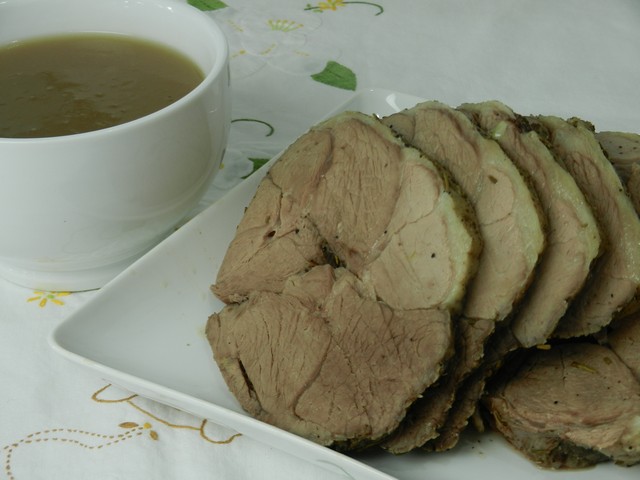
A leg of lamb; just how do you prepare it? As I started reading about it on the internet I found a lot of conflicting information. Some methods say to slow cook on low heat, others suggest higher heat. I cooked three boneless legs, around 4-5 Lb each, over a period of time using slightly different approaches and with only small differences in the results. All three ended up with tough connective tissues in them, which I later found out is just the nature of the leg portion of lamb. I also found out that leg of lamb is considered a lean and tender cut of meat, and dry, moderate heat is recommended to preserve that tenderness and moisture. This is confusing since other sources say that with the tough connective tissues in leg of lamb, it needs to be cooked low and slow to help tenderize these tissues. I didn’t know any of that when I cooked up these three pieces of meats, so I cooked at medium heat once, and low heat twice, but all three methods were moist heat.
The results? All three ways resulted in succulent meat, though I thought the medium-well legs were a little less tender than the leg I cooked to well-done. This may have been a carving problem as you are supposed to cut against the grain, and I’m not sure I did a very good job making sure of this the first two times. Cutting against the grain will help the meat seem more tender simply because the long fibers are cut so you don’t have to chew so much. As stated above, another thing that all three legs had in common was that the connective tissues were, indeed, tough, which was frustrating when eating. Especially for my kids. So there were areas (the connective tissues) in between the tender meat that were hard to chew, needing to be removed while eating or we had to spit it out. The meat tasted so good though, so I was willing to deal with it. Especially the last time when I cooked it to a more well-done state, did I really love it! Please read on!
If you do try this recipe, I would really appreciate a quick comment with a star rating (option found immediately under each recipe). It helps me out tremendously! Thanks in advance!
Verdict?
Well, I have yet to try dry heat at 300º, searing in a frying pan before baking and without covering. Until then, I suppose of these three ways, my preferred method would be the third one when I slow cooked in moist heat at 200º (on low in the crock pot), allowing the meat to come to an internal temperature of 165º. See details below. Had it not been for the tough connective tissues I would have been totally sold! I’m not sure that cooking on medium dry heat will make a difference for the connective tissues, since I’m reading that this part requires low and slow. So, really, the only thing I’m thinking you’d accomplish would be even more tender meat. If anyone has experience to share regarding these tough connective tissues (collagen) and knows what to do, I would love to hear from you; please leave a comment!
I used both crock pot and oven. Below is described what I did each time, using pictures and details of how to prepare it. Two of them were prepared in a crock pot; once on regular / high heat, once on low, and one time I baked it in the oven on low heat.
(For easy conversion of temperatures and measurements to the metric system, which is commonly used measurements in Europe, click on Conversions to Metric.)
First Leg:
I purchased a boneless leg of lamb, which weighed in at 4 1/2 Lbs.
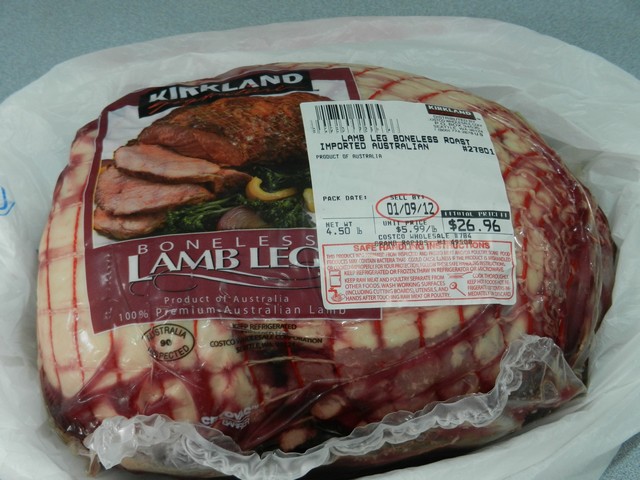
As for seasoning the meat, I decided to do what is traditionally done in Norway and use salt, pepper, rosemary, and garlic. Looking at a variety of different recipes and not only Norwegian ones, I found that these spices are commonly used with lamb, so the flavors are definitely tried and true. I started by rinsing the meat, patted it dry with paper towels, and seasoned it using 2 tsp salt, 1/2 tsp pepper, and 1 tsp rosemary, inside and out. I decided I would cook the meat in the crock pot.
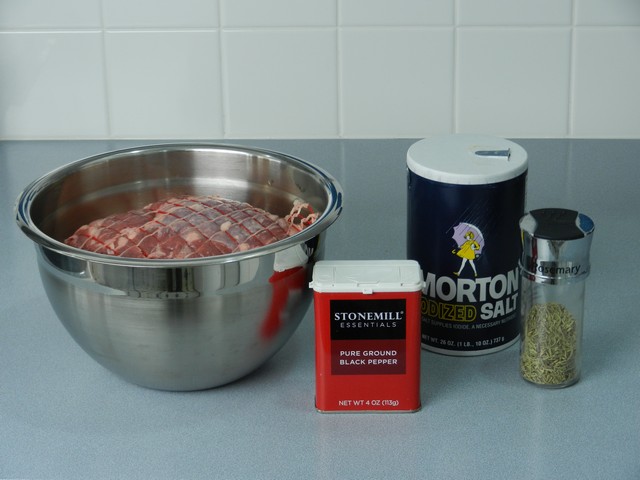
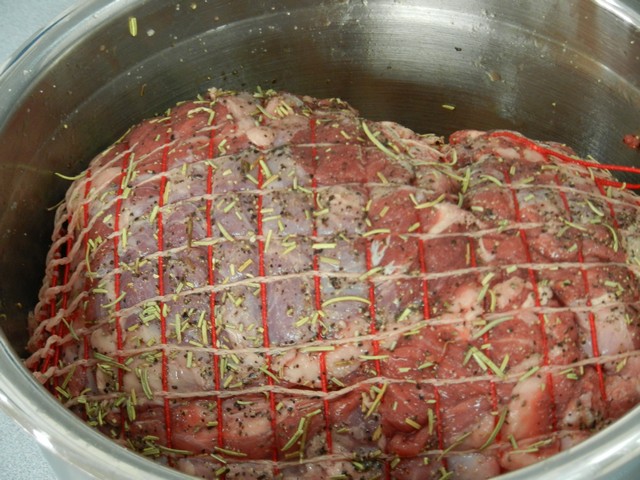
Then I peeled and sliced up garlic cloves. Most recipes say to use two, though I did three this time. Just got a bit excited!
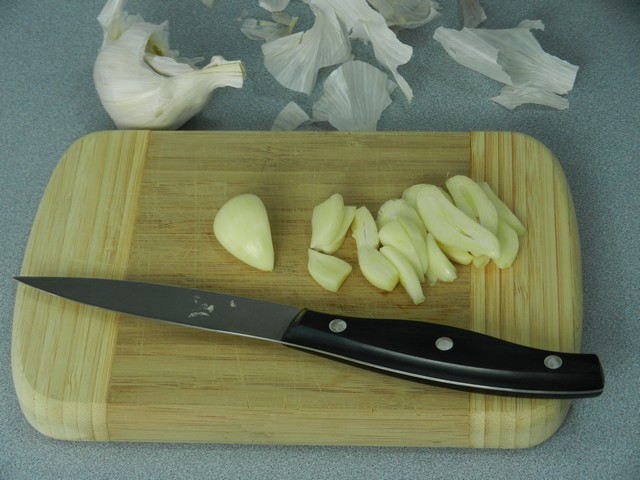
I stuck some of the slices inside the hollow of the leg that is left from the deboning process (which had already been done when I purchased it). Then, with a sharp knife I cut slits in the meat, enough to leave a slice of garlic in each slit. I continued this process until the garlic slices had been evenly distributed in the meat.
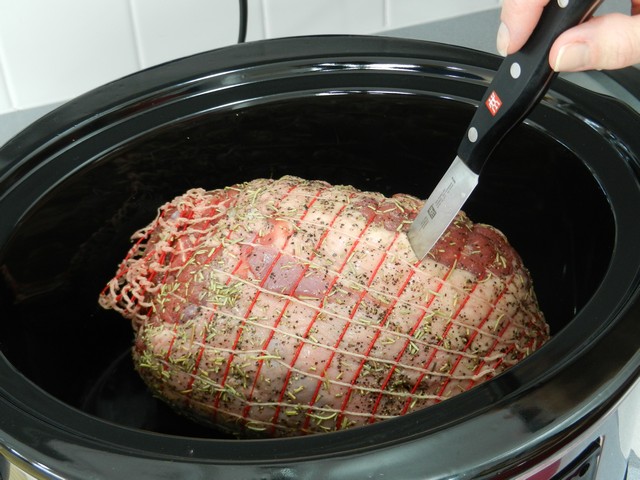
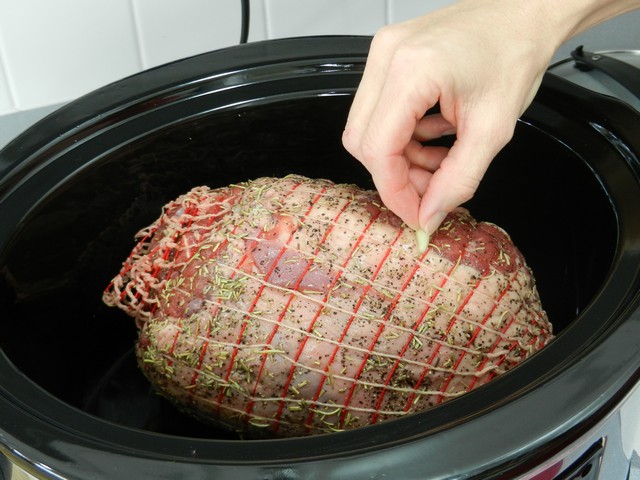
Then I added 1/2 c of water to the crock pot.

I used the digital thermometer attachment on my crock pot and set it to 160º F. (70º C). A thermometer should always be inserted into the thickest part of the meat, away from any bone. The lid went on, and being that I was in a bit of a rush that day, I cooked it on high (instead of low) for 3 hours.
Here’s a picture of my new crock pot. It has some neat features that intrigued me and so far they have turned out to be very useful. It comes with several programs, a “keep warm” setting, and a thermometer that makes the crock pot shut off automatically once the desired temperature has been reached.
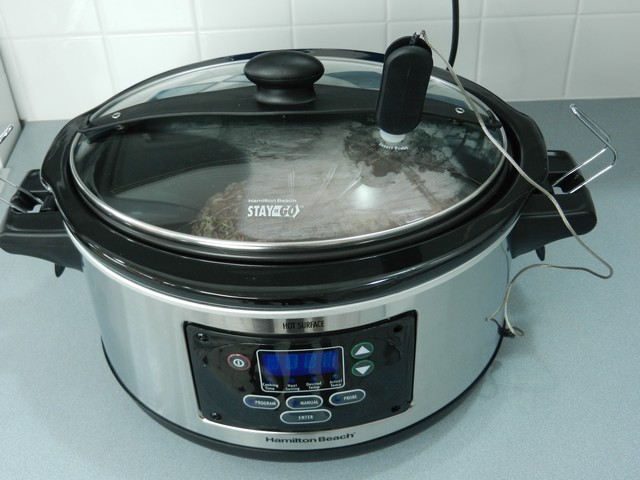
I also added potatoes to the pot along with scallions (leeks are even better, but I had scallions on hand), which adds great flavor to the drippings used for gravy.
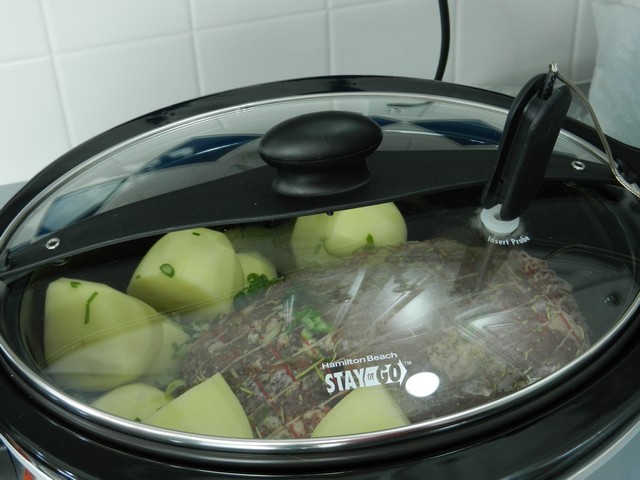
After 3 hours on high, the temperature had been reached. It was done and the crock pot switched to “warm”. I put the meat on a carving board to rest under aluminum foil for 15-20 minutes before carving to let the juices settle, otherwise the juices will leak out and cause dry meat. l then cut away the netting before carving in thin slices against the grain. This is how it should be cut; against the grain. I’m not sure I did a very good job with that on my first two roasts, so that may have played a role in how we experienced the chewiness of the meat.
Results:
The meat was very juicy and the drippings made wonderful gravy. (I think the potatoes were good as well, but I honetly can’t remember…) The meat turned out great, just a little bit chewier than we would have liked.
I decided to try it on low for 6-7 hours next time because I was thinking that slow cooking usually seems better for just about any kind of meat. Well, that might not be entirely true… Turns out that lean, tender meats prefer dry, medium heat. Not that it seemed to have made a difference for the legs of lamb that I prepared, but that’s what the general rule is.
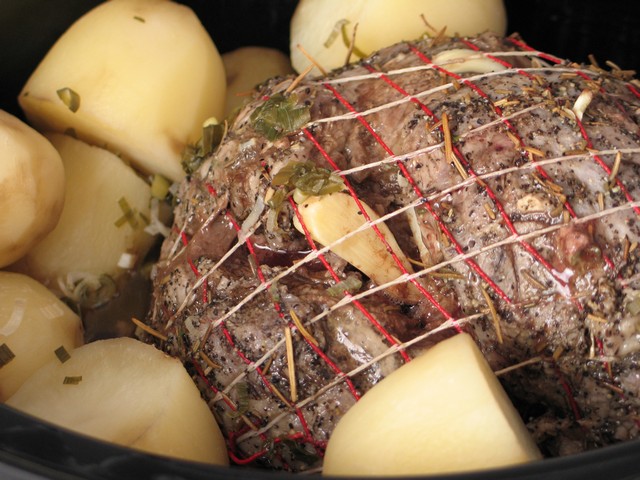
A lamb leg can also easily be cooked in the oven either at 350º F (175º C), or you can slow cook at anywhere from 200-325° F (94- 125º C). Slow cooking in the oven is what I did the second time I tried it.
A few words on temperatures:
A thermometer should be used to determine when the meat is done to your liking, instead of merely guessing or checking with a knife etc. With a thermometer you will know what the status is, no guesswork necessary, and no risk of making a mistake and ending up with over- or under done meat. The internal temperature should read anywhere from 120-145º F (50-64º C) for rare, depending on how rare you like it, 150-160º F (65-70º C) for medium, and 169º F (76º C) for well done. Be aware, however, that it is generally recommended to cook to at least 160º as the flavor will be better than at lower temperatures. The meat should be taken out of the oven or heat source before it has reached the final internal temperature that you want, since the temperature will continue to rise by a few degrees as it sits. You may otherwise end up with meat that is overly done for your liking, and possibly tough and dry if it already has reached a “well done” temperature.
Second Leg:
This time I roasted the leg in the oven. In addition to the same seasonings as the first time, I added half a leek, potatoes, and a half cup of water, and placed it all in a greased pan with tall sides to catch the drippings. I inserted a thermometer and covered tightly with foil.
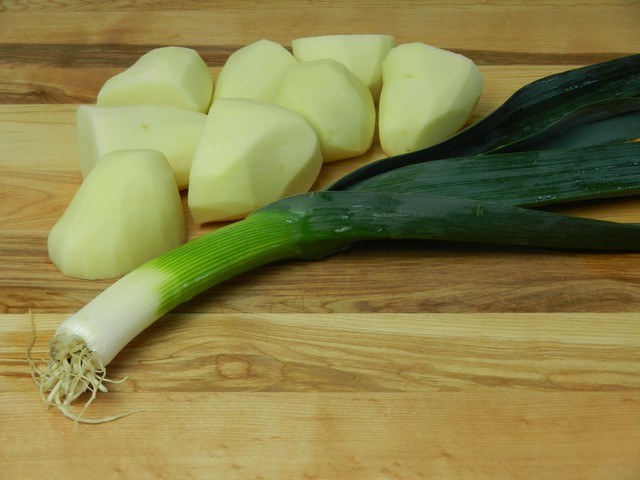
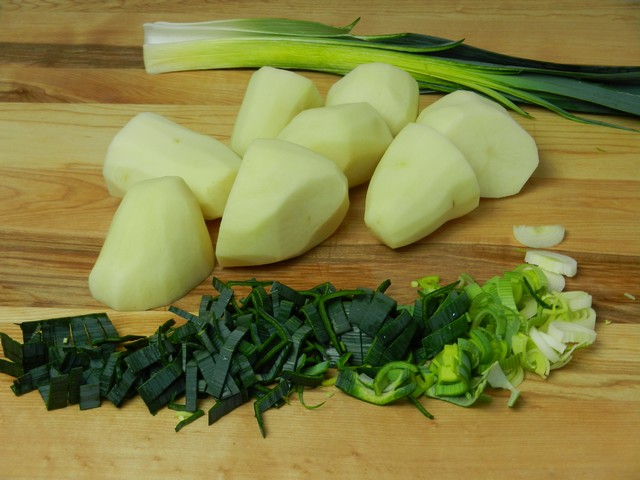
A digital thermometer is a great investment. The type of thermometer I normally use when not using my crock pot is very convenient in how it makes it quick and easy to measure the temperature of the meat. Mine has a probe that you can leave in the meat for the entire time and a wire that goes from the oven to the digital screen that is left on the counter top, which makes it very easy to use and read.
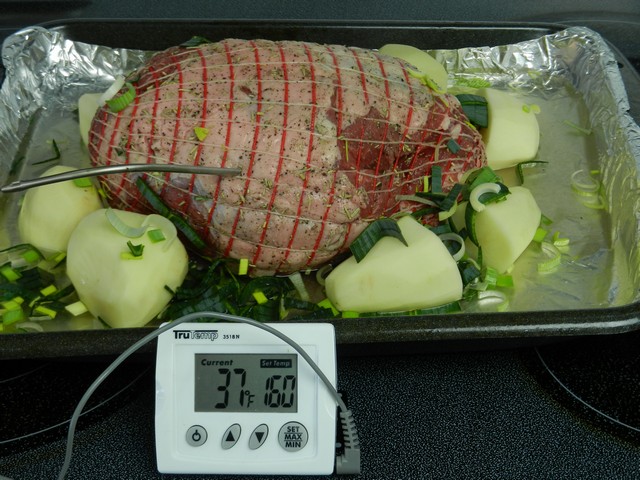
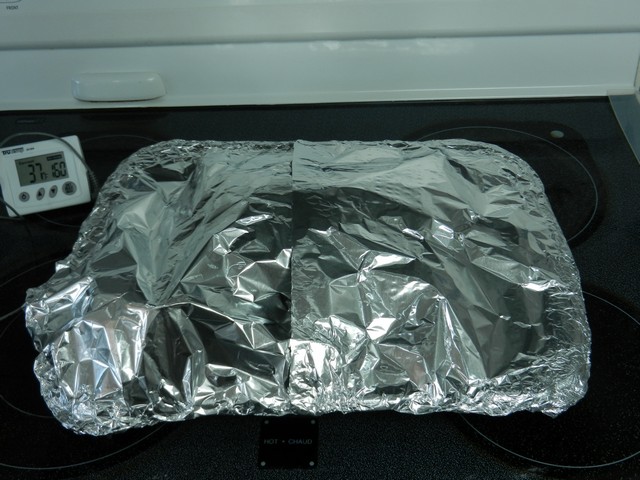
I set the oven temperature to 200°F and baked until the thermometer read 160ºF, then let it sit for 15 minutes. The meat continued to rise 4 more degrees in temperature, which is considered medium-well done.
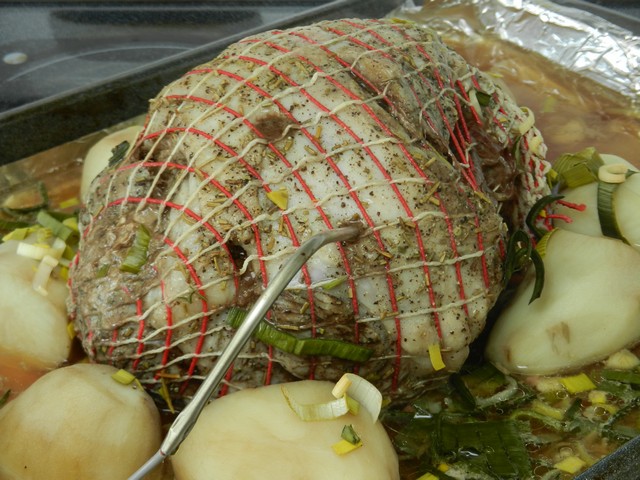
Results:
When I carved the meat it was very juicy, but again, not especially tender. The connective tissues were also tough in places. I decided that I would cook the meat to 165º next time to see if that would make a difference. Adding half a leek was perfect and the gravy was wonderful! I added nothing but cornstarch. The potatoes were a disappointment, however. They were fairly hard and not nearly done. They were edible, just not very enjoyable. I decided I would have to do them separately or pre-bake them for a while before adding the meat.
Third Leg:
The third leg was seasoned using only salt and pepper, placed in the crock pot again with a half cup of water, temperature set on low and with the thermometer set at 165º. Again my goal was juicy, tender meat: Knowing that the internal temperature would continue to rise a little bit after cooking and the meat potentially ending up over done, tough and dry, I had set the thermometer to register “done” at the higher side of medium both times. The hope was to have the temperature rise to well done in the end, but certainly not over done. However, I found that the temperature didn’t rise quite enough and the meat wasn’t as tender as I had hoped. Juicy, yes, and it was juicy all three times. This third time, however, I decided to up the temperature a little bit. Cooking it in the crock pot on low (moist heat) until it reached 165º before turning it off seemed to do the trick. It took 5 1/2 hours. Every crock pot is different though, and cooking time will also vary depending on the size of the leg.
Results:
Measuring a half hour later, which is a bit late, the meat measured 168º, possibly coming down from a slightly higher temperature since it had been sitting a while. The meat was very tender and juicy, and not chewy at all. Carefully cutting against the grain may also have helped with any chewiness. I do think that baking to a higher internal temperature did make a difference in the end. There was still some fat and connective tissue in and around the meat that had not dissolved, so that left some chewy areas just like the other times. But the meat itself, once trimmed of fat, was amazingly tender and juicy! When I poured on gravy made from the drippings, it was hard not to overeat!
As it turns out, although using rosemary and garlic is a very traditional way of preparing lamb both in Norway and in other countries as well, my family ended up preferring the simple flavor of using only salt and pepper. Lamb is so flavorful in itself! It is quite different from beef, just to compare. And no, it does not taste like chicken! Ha!
Another small change this time around was that I added another half teaspoon of salt (using 2 1/2 tsp) to the meat before cooking, which ended up being just right for us. The broth seemed a bit salty when I tasted it but once the gravy was made and it was poured over the potatoes and meat, it was just the way we like it and no extra salt at the table was needed. I did not add potatoes this time but opted to cook those separately.
To make gravy I ladle and drain the broth through a colander directly into a medium sized pot, and bring it to a boil. Then I mix a couple of tablespoons of cornstarch into to a small cup of water. While whisking the boiling broth pretty briskly, careful not to splatter and get burned, I pour in a thin but steady stream of the cornstarch mixure until the gravy is thickened to our liking. As soon as it is thick enough, I stop pouring and discard the leftover cornstarch mixture. You must whisk the entire time while adding the stream of cornstarch to prevent lumps. As soon as it reaches a boil again, the gravy is done. Depending on how much seasoning is already in the broth, it can sometimes be necessary to add salt and spices but make sure to taste first before adding anything.
I hope I have provided you with some insights on how to successfully cook a tender, juicy leg of lamb. Please comment and add a star rating to this recipe if you try it; option is found immediately under the recipe. Thank you!!
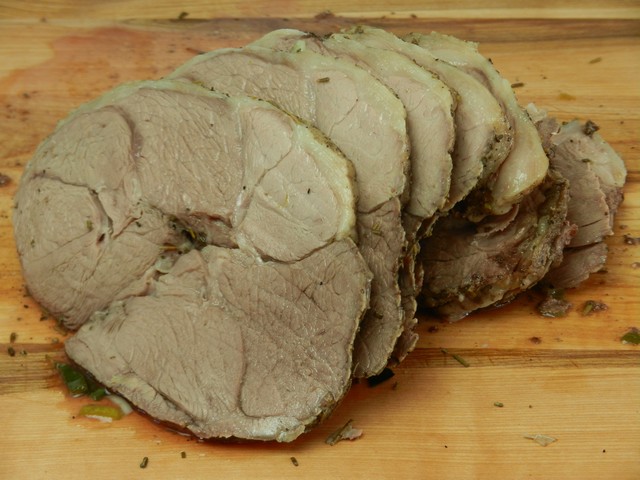
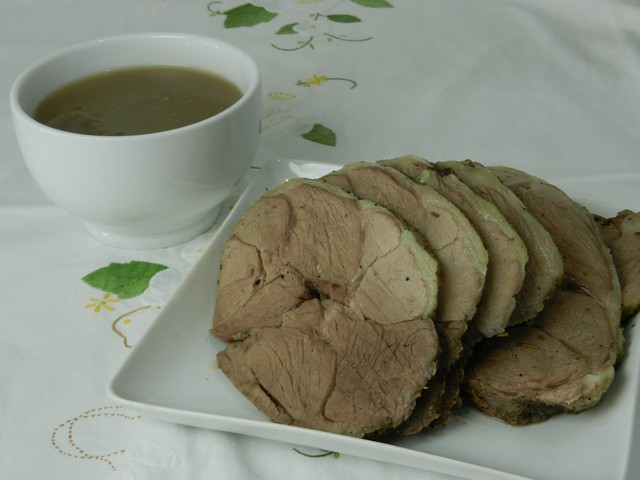
- 1 4-5 Lb boneless leg of lamb
- 2 tsp salt
- ½ tsp pepper
- 1 tsp dried rosemary
- 2 garlic cloves
- ½ c water
- Rinse the meat, pat dry with paper towel.
- Rub inside the hollow and on the outside with salt, pepper, and rosemary.
- Peel and thinly slice the garlic cloves.
- Cut slits into the meat, about 1 in. deep, and push a slice of garlic into each slit until garlic is evenly distributed in the whole leg. Also add some slices inside the hollow of the leg.
- Put the leg in a crock pot, along with ½ c water.
- Cook for 5 -7 hours on low, or until desired temperature has been reached: 145º F for rare, 150-160º F for medium, and 169º F for well done. Keep in mind that the internal temperature will continue to rise a few degrees after it is done cooking.
- Alternatively, a leg of lamb can be roasted in the oven at 350 degrees F for 2-3 hours, until desired temperature has been reached. If using the oven, place in a baking dish with sides of at least 1½ in. to catch the drippings.
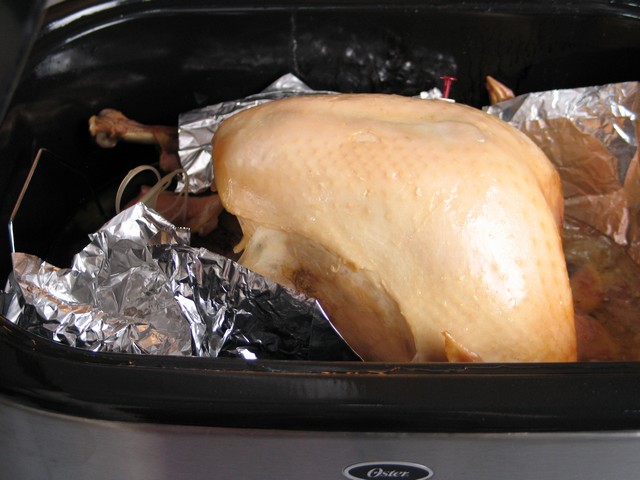
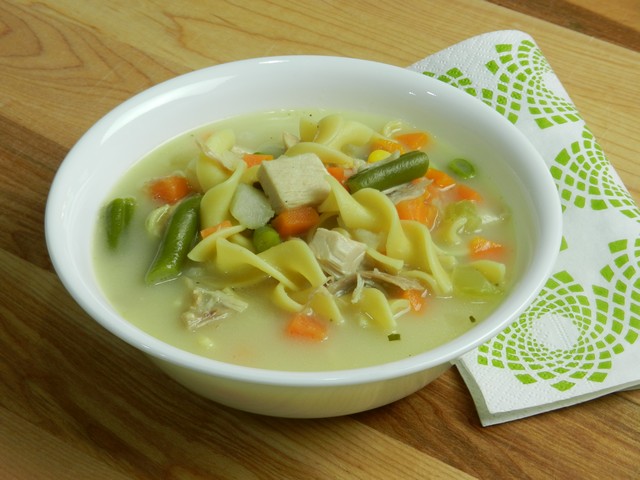
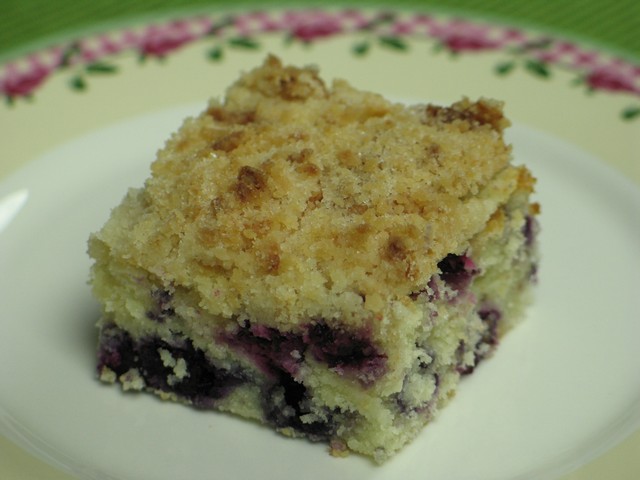
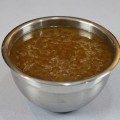
I’m going to do this today.Slow cook 4,7 lbs for 5 hours. New Years Eve 2012. (I googled and found this. Fun cause I’m Norwegian too. Living in DC area)
How nice to hear from a fellow Norwegian! I hope your lamb turned out good! And hopefully you had a thermometer to guide you along. 🙂
It was perfect. Had it on high for 4 hours, then low for nearly one hour. Rested 13 min. Then we HAD to eat 🙂 Served with potatoes au gratin,a la Mia, carrots and broccoli. Didn’t have lingonberries,so used rasberry (Polaner all fruit with fiber) Yum,yum,yum. Had sparkling cider and for dessert fruit cake and Puerto Rican Coquitos
Coquito
2 egg yolk, beaten
1 can evaporated milk
1 can cream coconut
1 can sweetened condensed milk
1 cp white rum (jamican white rum)
1/2 cp water
1/4 tsp cloves
1 tsp vanilla extract
Boil
egg & evaporated milk until thick; In blender cream
of coconut, condensed milk, rum, water, cloves, vanilla, egg &
evaporated milk 30 secs
glass bottle chile overnight or place in freeze from two to four hours
Potatoes au gratin a la Mia
Fräs lök. Skiva färdigkokt potatis. Varva i en ugnsform med grillkrydda
på varje lager. Häll över grädde o ev lite mjölk. Ugnsgratinera i 225
grader ca 10 min. Skiva över ost o gratinera 15 min till. Klart!
I’m so glad to hear it went well! And thanks for those recipes, sounds yummy! In which part of the grocery store would you find cream coconut? Is it in a can, jar, carton? Thanks again!
Hispanic/ international food
Can 🙂
Thanks! 🙂
very nice blog
i,m having a new kitchen installed which has been gutted
no way to cook for a while so i bought a crock pot which iv’e never used before
thanks for the info
i like your style of writing
i can tell you are a passionate cook/chef
Wow. How thorough! Your recipe and information is awesome. I love lamb but have never prepared it in a crock pot before and wanted to try it. I googled “leg of lamb” and “crock pot” and this came up. Your detailed description of how you tried to cook it was terrific and honest. Thank you. This was perfect.
Thank you very much, that was nice to hear! Glad you liked it! 🙂
My mother had an old manual meat thermometer . I am cooking a boneless leg of lamb for the first time in a crock pot, today. Mother’s thermometer says lamb should be cooked to 180 F . My roast has to be served at a dinner this evening. I hope it will be done in time. It is over 6 lbs. approx. 1:30 pm now. thanks for your insights.
Lamb is one of those meats that can be done at different temperatures, depending on what you prefer. It can be eaten rare or up to well done, just like beef. I’m sure there are many different opinions on what is the perfect temperature for lamb. I hope your dinner turns out fantastic!
I am going to roast my 31/4 lb boneless leg of lamb in the crock pot to make gyros. Do you have any suggestions as how to do this?
I’ve never made gyros before, so I’m not sure how that’s done. Maybe just follow the crock pot instructions above until it’s done to your liking? I’m sorry I can’t help you better! Hope you figure it out!
Great recipe, thank you. Really like your blog.
Thank you! That’s nice to hear, I appreciate your comment!
I made this recipe with some modifications. I used 1/2 teasp. of salt; 3/4 teasp. pepper; 3 tablespoons of crushed garlic; zest of one lemon; juice of half a lemon; 3/4 cup dry red wine; 2 teasp. of dried rosemary. I mixed everything into a paste (minus the wine), cut many slits into the meat and rubbed the paste into the cuts. I then put it in the pot along with the red wine. I coked it as recommended on low with the same type of crock pot. It was done in 5-1/2 hours and was absolutely delicious! Very moist and the juice was flavorful; most people poured some on the meat and on their homemade mashed potatoes. Six people devoured it in short order. And I thought I would have leftovers!
Sounds delicious!! How wonderful that it turned out so nice for all of your guests! With no leftovers, it obviously was a hit! Thank you for sharing!
what if you dont have all the ingredants to put in with it i mean i have some but not all
That’s fine, just use what you have. Salting the meat is important, but not technically necessary. You could add salt after it’s done. But if possible, use some water, salt and pepper, then add vegetables of your choice as sides.
love your blog to informative, Going to try this tomorrow as it is thawing today. my mouth is watering already. will use the crock version.
Thank you! I hope you’ll love it!
I am so glad to get an official crock pot recipe…. My stove caught on fire …long story… and the stove I ordered will not be in for several weeks. I am using the crock pot, air fryer, stove top burners @nd microwave. We have a tradition of Leg of Lamb &or Easter and I will use your recipe with a little addition from a very old Helen Corbett cook book and add a little slice of lemon with the inserted garlic… yum, yum..thank you.
I’m so sorry to hear about your stove catching on fire, how scary!! Also frustrating to have to make do without a stove for so long, but sounds like maybe your house is intact and that would be a relief for sure. I’m glad I could help you with this recipe; cooking lamb in a crock pot may not be a very traditional way to handle such a beautiful cut of meat, but if it turns out delicious in the end then that’s what’s most important. I hope you’ll continue to find great crock-pot recipes to get you through these next few weeks! All the best to you, thank you for leaving a comment!!